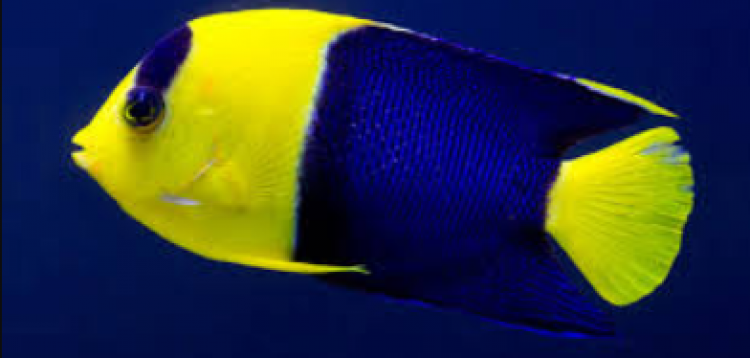- Name:
Pygmy Yellowtail Angelfish
(View AKA's) - Family: Pomacanthidae
- Species: Angel Dwarf
- Scientific Name: Centropyge flavicauda

General info about Pygmy Yellowtail Angelfish
One of the smallest members of the Centropyge genus, the Pygmy Yellowtail Angelfish rarely grows to over two inches and its body and face are primarily blue and the caudal fin is white. It requires numerous hiding places and large amounts of live rock for grazing on microalgae. Not a good reef dweller, the Pygmy Yellowtail Angelfish is prone to nip at stony and soft corals (sessile invertebrates) and clam mantles. It can be very territorial and will often kill other Dwarf Angels, and harass any docile fish. One male and several females can be kept together. The Pygmy Yellowtail Angelfish can be bred in an aquarium but has no distinguishing characteristics that differentiate males from females.
Pygmy Yellowtail Angelfish Diet & Nutrition
Being an omnivore, the Pygmy Yellowtail Angelfish's diet should include Spirulina, marine algae, high-quality angelfish preparations containing sponge matter, fortified brine shrimp, mysis, and other meaty items. It is recotmmended that they are fed twice a day.
Determining Sex of Pygmy Yellowtail Angelfish
Being protogynous hermaphrodites, the Pygmy Yellowtail angelfishes are born as female and undergoes sex reversal when the need arises. It is usually the larger and more dominant individual that turns to become male.
Breeding & Spawning Pygmy Yellowtail Angelfish
They are likely to be open water spawners, and as with other dwarf angels. Pygmy yellowtail angelfish often group into harems with 1 dominating male individual and 3 to 4 female angelfishes. It is best to keep a large and small individual are kept together to encourage breeding. Courtship usually begins at dusk when male soars above the female, hovers with his fins extended, and tilts at a 45-90 degree angle from the bottom. When the female is ready to spawn, it follows the male and initiates spawning with a mutual soaring display.
Common Diseases with Pygmy Yellowtail Angelfish
A tank with plenty of places to hide and clean water is the best way to prevent illness for dwarf angels such as Pygmy Yellowtail angelfish. However, they are also susceptible to contract common bacterial diseases such as Cotton wool disease, Vibrio bacterial disease, and Fish tubercolosis.
Aside from bacterial diseases, angelfishes my be affected by common reef scourges such as the Crypt or White Spot Diseases and Velvet Disease. Tiny white spots on the skin of the fish is one of the tell-tale sign of infection of the Crypt while dusty golden film on the skin or the eyes of the angelfish will detect the presence of Velvet Disease.
Pygmy Yellowtail Angelfish Origin
Presence of this species in the wild ranges from East Africa, east to the Philippines, north to Southern Japan, and south to the Great Barrier Reef in Australia.
Caution with Pygmy Yellowtail Angelfish
Pygmy yellowtail angelfishes are quite social with fish its size or larger, yet not on smaller species since it tends to become bullies. It is not known for nipping at coral or clam mantles but caution is advised when adding this fish to a reef tank as it is still a Centropyge Angelfish.
Acclimating Pygmy Yellowtail Angelfish
It is recommended that this species be added to a well-established aquarium containing lots of live rock that will provide caves and crevices to explore and hide in when feeling threatened. It should be added last in tanks to avoid aggression towards newer fishes.
Original Detail
| Name | Species | Family | Scientific Name | More Detail | Added by |
|---|---|---|---|---|---|
| Pygmy Yellowtail Angelfish | Angel Dwarf | Pomacanthidae | Centropyge flavicauda | One of the smallest members of the Centropyge genus, the Pygmy Yellowtail Angelfish rarely grows to over two inches and its body and face are primarily blue and the caudal fin is white. It requires numerous hiding places and large amounts of live rock for grazing on microalgae. Not a good reef dweller, the Pygmy Yellowtail Angelfish is prone to nip at stony and soft corals (sessile invertebrates) and clam mantles. It can be very territorial and will often kill other Dwarf Angels, and harass any docile fish. One male and several females can be kept together. The Pygmy Yellowtail Angelfish can be bred in an aquarium but has no distinguishing characteristics that differentiate males from females. |
PalaciosAn |
Changed by users
| Submitted Date | Submitted By | Status | Action |
|---|




